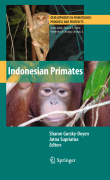
Indonesia possesses the second largest primate population in the world, with over 33 different primate species. Although Brazil possesses more primate species, Indonesia outranks it in terms of its diversity of primates, ranging fromprosimians (slow lorises and tarsiers), to a multitude of Old World Monkey species (macaques, langurs, proboscis moneys) to lesser apes (siamangs, gibbons)and great apes (orangutans). The primates of Indonesia are distributed throughout the archipelago. Partly in response to the number of primates distributedthroughout the Indonesian archipelago, Indonesia is classified as the home oftwo biodiversity hotspots (Wallacea and Sundaland). In order to be classifiedas a hotspot, an area must have a large proportion of endemic species coupledwith a high degree of threat including having lost more than 70% of its original habitat. Two areas within Indonesia meet these criteria. The tremendous diversity of primates in Indonesia, in conjunction with the conservation issues facing the primates of this region, created a need for this volume. Indonesia is home to an extraordinary diversity of primates and conservation hotspots Will showcase the most up to date research on the behavior, ecology and conservation status of Indonesian primates INDICE: Dedication, Acknowledgments, List of Contributors. 1-Introduction.- Part 1 Indonesia’s Apes. 2-Measuring Performance of Orangutan Protection andMonitoring Unit: Implications for Species Conservation. 3-Communication, Culture and Conservation in Orangutans. 4- The Natural History of Sumatran Orangutan (Pongo abelii. 5-Javan Gibbon (Hylobates moloch): Population and Conservation. 6-Siamang Socioecology in Spatiotemporally Heterogenous Landscapes: Do ‘Typical’ Groups Exist? 7-Impact of Forest Fragmentation on Ranging and Home Range of Siamang (Symphalangus syndactylus) and Agile Gibbons (Hylobates agilis. 8-Behavioral Ecology of Gibbons (Hylobates albibarbis) in a Degraded Peat SwampForest. 9-Effects of Habitat Quality on Primate Populations in Kalimantan: Gibbons and Leaf Monkeys as Case Studies.- Part 2-Indonesia’s Monkeys. 10-Predator Recognition in the Absence of Selection. 11-The Relationship Between Nonhuman Primate Densities and Vegetation on the Pagai, Mentawi Islands, Indonesia. 12-Proboscis Monkey (Nasalis larvatus): Bio-Ecology and Conservation. 13-Pest,Pestilence and People: The Long-tailed Macaque and its Role in the Cultural Complexities of Bali. 14-The Not so Sacred Monkeys of Bali: A Radiographic Study of Human-Primate Commensalism. 15-Male-Male Affiliation in Sulawesi Tonkean Macaques. 16-Ecology and Conservation of the Hose's Langur Group (Colobinae: Presbytis hosei, P. canicrus, P. sabana): A Review. 17-Thomas Langurs: Ecology and Sexual Conflict and Social Dynamics. 18-Dominance and Reciprocity in the Grooming Relationships of Female Long-tailed Macaques (Macaca fasicularis) in Indonesia. 19-Selamatkan Yaki! Conservation of Sulawesi crested black macaques Macaca nigra.- Part 3-Indonesia’s Prosimians. 20-The Function of Scentmarking in Spectral Tarsiers. 21 The Population Ecology of Dian's Tarsier. 22-Using Facial Markings to Unmask Diversity: The Slow Lorises (Primates: Lorisidae: Nycticebus spp.) of Indonesia. 23-Conclusions.- Index.
- ISBN: 978-1-4419-1559-7
- Editorial: Springer
- Encuadernacion: Cartoné
- Páginas: 300
- Fecha Publicación: 01/02/2010
- Nº Volúmenes: 1
- Idioma: Inglés
